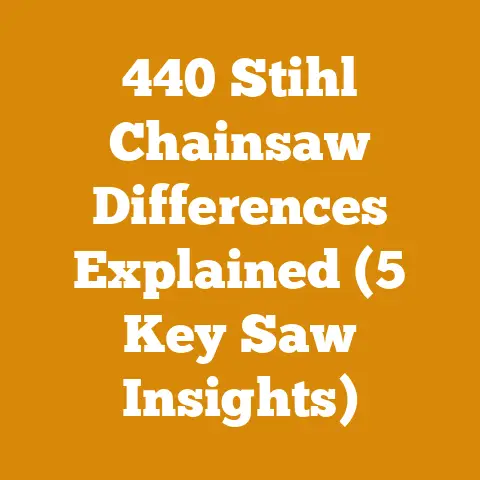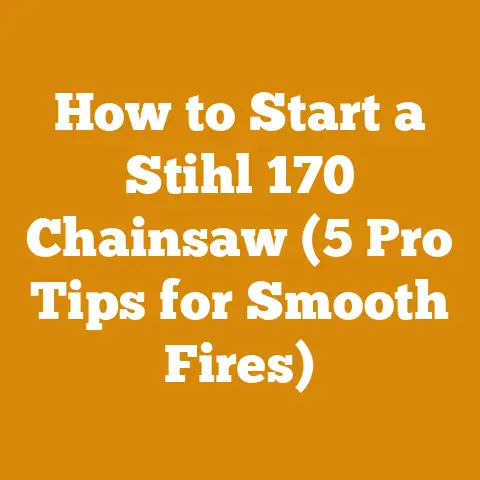4 Cycle Stihl Weed Eater (5 Pro Tips for Optimal Strimming)
Imagine little Timmy and Suzie, running through the backyard, their laughter echoing as they chase butterflies. The yard, their kingdom, their playground. But what if the kingdom is overrun? What if the tall grass and unruly weeds transform their magical land into a prickly, uncomfortable place? That’s where the trusty weed eater comes in – a modern-day Excalibur, ready to reclaim the lawn.
But let’s be honest, running a 4-cycle Stihl weed eater isn’t as simple as pulling a cord. It’s a tool, a powerful one, and like any powerful tool, it needs respect, understanding, and a little bit of know-how to make it sing. And, of course, it comes with costs. From the initial purchase to fuel, maintenance, and even the occasional string replacement, it all adds up. As someone who’s spent countless hours battling the green invaders with various weed eaters, including my faithful Stihl, I’m here to share my hard-earned wisdom and shed light on the costs involved.
In this article, I’m going to delve into the world of the 4-cycle Stihl weed eater, focusing on five pro tips for optimal strimming. We’ll explore how to get the best performance from your machine, extend its lifespan, and, crucially, manage the costs associated with it. We’ll also break down the expenses involved in maintaining a well-kept lawn, from fuel and oil to replacement parts and even potential repairs. Let’s get started!
4-Cycle Stihl Weed Eater: 5 Pro Tips for Optimal Strimming
A 4-cycle Stihl weed eater is a fantastic tool, offering a balance of power, efficiency, and user-friendliness. However, to truly unlock its potential, understanding its nuances is key. Here are five pro tips I’ve learned over the years that will help you achieve optimal strimming performance and extend the life of your machine:
1. Mastering the Art of the Trim: Technique and Angle
The first, and perhaps most crucial, tip is mastering the technique. It’s not just about swinging the weed eater around haphazardly. The angle at which you hold the trimmer head and the speed at which you move are critical for a clean, efficient cut.
- The Angle: Aim for a slight angle, with the cutting head tilted slightly towards the area you’re trimming. This allows the string to slice through the grass and weeds rather than simply beating against them. I’ve found that a 15-20 degree angle works well in most situations.
- The Speed: A slow, deliberate pace is generally better than a frantic one. Moving too quickly can result in uneven cuts and missed patches. Let the string do the work, and focus on maintaining a consistent height.
- Overlapping Passes: Overlap each pass by a few inches to ensure complete coverage and eliminate any stray blades of grass.
- Edging: For edging along sidewalks and driveways, tilt the trimmer head vertically and use the string to create a clean, defined line. Be careful not to hold it too long in one spot, as this can damage the string and potentially the surface you’re edging.
Cost Implications: Proper technique reduces strain on the engine and cutting head, leading to fewer repairs and a longer lifespan for your weed eater. It also minimizes string breakage, saving you money on replacement spools.
2. Fueling the Beast: Choosing the Right Fuel and Oil
A 4-cycle engine requires both gasoline and oil, but unlike 2-cycle engines, they are kept separate. Using the wrong type of fuel or oil can wreak havoc on your engine, leading to costly repairs or even complete failure.
- Fuel: Always use fresh, high-quality gasoline with an octane rating of 87 or higher. Avoid using old or stale gasoline, as it can gum up the carburetor and cause starting problems. I prefer using gasoline with ethanol content no higher than 10% (E10), if possible.
- Oil: Use a high-quality 4-cycle engine oil specifically designed for small engines. Stihl recommends their own brand of oil, but any reputable brand that meets the API service classification of SJ or higher will suffice. I typically use a synthetic blend oil for better performance and protection.
- Mixing: There’s no mixing required with a 4-cycle engine. Simply fill the gasoline tank with gasoline and the oil reservoir with oil. Always check the oil level before each use and top it off as needed.
- Storage: If you’re storing your weed eater for an extended period, add a fuel stabilizer to the gasoline tank to prevent the fuel from breaking down and causing problems. I also recommend draining the carburetor bowl to remove any remaining fuel.
Cost Implications: Using the correct fuel and oil is a preventative measure that can save you significant money in the long run. Cheap gasoline or the wrong type of oil can lead to engine damage, requiring expensive repairs or even a complete engine replacement.
Data Point: According to a study by the Outdoor Power Equipment Institute (OPEI), using the wrong type of fuel is a leading cause of small engine failure, resulting in millions of dollars in repair costs annually.
3. Stringing Along: Choosing the Right String and Maintaining the Head
The cutting string is the heart of your weed eater, and choosing the right type and maintaining the cutting head are essential for optimal performance and longevity.
- String Type: Different types of string are available, each with its own strengths and weaknesses. Round string is the most common and is suitable for general trimming. Square string is more aggressive and is better for cutting through thicker weeds. Twisted string is a good compromise between round and square string, offering a balance of cutting power and durability. I generally use a .095-inch diameter round string for most of my trimming needs.
- String Diameter: The diameter of the string also affects its performance. Thicker string is more durable and can cut through thicker weeds, but it also puts more strain on the engine. Thinner string is less durable but is easier on the engine and provides a cleaner cut. Consult your owner’s manual for the recommended string diameter for your weed eater.
- String Loading: Loading the string correctly is crucial for proper operation. Follow the instructions in your owner’s manual carefully. Overfilling the spool can cause the string to bind and break, while underfilling it can result in uneven cuts.
- Head Maintenance: Regularly inspect the cutting head for wear and tear. Clean it periodically to remove debris and ensure that the string advances smoothly. Replace the head if it becomes damaged or worn.
Cost Implications: Choosing the right string and maintaining the cutting head can significantly reduce string breakage and extend the life of the head itself, saving you money on replacement parts.
Personal Story: I once tried using a cheap, off-brand string and ended up spending more time replacing it than I did trimming. The string kept breaking, and the cutting head quickly wore out. It was a classic case of being penny-wise and pound-foolish. I learned my lesson and now only use high-quality string from reputable brands.
4. Taming the Beast: Air Filter and Spark Plug Maintenance
The air filter and spark plug are essential components of your weed eater’s engine. Keeping them clean and in good condition is crucial for optimal performance and fuel efficiency.
- Air Filter: The air filter prevents dirt and debris from entering the engine. A dirty air filter can restrict airflow, reducing power and increasing fuel consumption. Clean the air filter regularly, typically every 25 hours of use. You can clean a foam air filter with warm water and mild detergent. A paper air filter should be replaced when it becomes dirty.
- Spark Plug: The spark plug ignites the fuel-air mixture in the engine. A worn or fouled spark plug can cause starting problems, misfires, and reduced power. Replace the spark plug annually or after every 100 hours of use. Use the correct spark plug for your weed eater, as specified in your owner’s manual.
- Checking the Spark Arrestor: Many weed eaters have a spark arrestor screen. Check it periodically and clean it with a wire brush to ensure proper exhaust flow.
Cost Implications: Maintaining the air filter and spark plug is a simple and inexpensive way to improve your weed eater’s performance and fuel efficiency. It can also prevent more serious engine problems, saving you money on repairs.
Data Point: A study by the University of California, Davis, found that a dirty air filter can reduce engine power by as much as 10% and increase fuel consumption by as much as 20%.
5. Storing for Success: Proper Storage and Winterization
Proper storage is crucial for extending the life of your weed eater, especially during the off-season.
- Cleaning: Before storing your weed eater, clean it thoroughly to remove any dirt, debris, or grass clippings.
- Fuel: Empty the fuel tank or add a fuel stabilizer to prevent the fuel from breaking down and causing problems. I prefer to drain the carburetor bowl as well.
- Oil: Change the oil if it’s been a while since your last oil change.
- Storage Location: Store your weed eater in a clean, dry place, away from direct sunlight and extreme temperatures.
- Battery (If Applicable): If your weed eater has a battery, remove it and store it in a cool, dry place.
Cost Implications: Proper storage prevents corrosion, fuel system problems, and other issues that can lead to costly repairs. It also ensures that your weed eater is ready to go when you need it.
Personal Experience: I once neglected to properly winterize my weed eater and ended up having to replace the carburetor the following spring. It was a costly mistake that I won’t make again.
The True Cost of Keeping Your Lawn Trim: A Deep Dive into Expenses
Owning and operating a 4-cycle Stihl weed eater involves more than just the initial purchase price. Understanding the true cost of keeping your lawn trim requires considering a range of factors, from fuel and oil to replacement parts and potential repairs. Let’s break down these costs in detail:
1. Initial Purchase Price: The Starting Point
The initial purchase price of a 4-cycle Stihl weed eater can vary depending on the model, features, and retailer. Generally, you can expect to pay anywhere from $200 to $500 for a quality machine.
- Entry-Level Models: These models are typically less expensive and are suitable for small to medium-sized yards with light trimming needs.
- Mid-Range Models: These models offer a good balance of power, features, and price. They are suitable for medium to large-sized yards with moderate trimming needs.
- Professional-Grade Models: These models are the most expensive and are designed for heavy-duty use. They are suitable for large properties, commercial landscaping, or frequent use.
Cost Considerations: When choosing a weed eater, consider your specific needs and budget. Don’t overspend on a model with features you don’t need, but also don’t skimp on quality, as a cheaper machine may end up costing you more in the long run due to repairs and a shorter lifespan.
2. Fuel and Oil: The Ongoing Expenses
Fuel and oil are ongoing expenses that you’ll need to factor into your budget. The amount you spend on fuel and oil will depend on how often you use your weed eater and the size of your yard.
- Fuel Consumption: 4-cycle engines are generally more fuel-efficient than 2-cycle engines. However, fuel consumption can still vary depending on the model, engine size, and operating conditions. On average, you can expect to use about 1 gallon of gasoline for every 2-3 hours of trimming.
- Oil Consumption: 4-cycle engines require oil changes at regular intervals. The frequency of oil changes will depend on the model and operating conditions. Consult your owner’s manual for the recommended oil change interval. A typical oil change requires about 1/2 quart of oil.
- Fuel Prices: Gasoline prices can fluctuate significantly depending on your location and the time of year. Keep an eye on gas prices and try to fill up when prices are low.
- Oil Prices: High-quality 4-cycle engine oil can cost anywhere from $5 to $15 per quart.
Cost Calculation: Let’s say you use your weed eater for 1 hour per week, and you need to change the oil every 50 hours. Assuming gasoline costs $4 per gallon and oil costs $8 per quart, your annual fuel and oil costs would be:
- Fuel: (1 hour/week * 52 weeks/year) / 2.5 hours/gallon * $4/gallon = $83.20
- Oil: (52 hours/year) / 50 hours/oil change * 0.5 quarts/oil change * $8/quart = $4.16
Total Annual Fuel and Oil Costs: $83.20 + $4.16 = $87.36
3. String Replacement: A Necessary Evil
String replacement is another ongoing expense that you’ll need to budget for. The amount you spend on string will depend on the type of string you use, the size of your yard, and the types of weeds you’re cutting.
- String Prices: String prices can vary depending on the type, diameter, and length. A spool of high-quality string can cost anywhere from $10 to $30.
- String Consumption: String consumption can vary significantly depending on the trimming conditions. Cutting through thick weeds or edging along concrete can cause the string to wear out more quickly.
Cost Calculation: Let’s say you use one spool of string per year, costing $20. Your annual string replacement cost would be $20.
4. Maintenance and Repairs: The Unexpected Costs
Maintenance and repairs are unexpected costs that you should factor into your budget. Even with proper care and maintenance, your weed eater may eventually require repairs.
- Common Repairs: Common weed eater repairs include carburetor cleaning or replacement, spark plug replacement, air filter replacement, and cutting head replacement.
- Repair Costs: Repair costs can vary depending on the type of repair and the mechanic you use. Simple repairs, such as spark plug replacement, may only cost a few dollars. More complex repairs, such as carburetor replacement, can cost $50 to $100 or more.
- Preventative Maintenance: Regular preventative maintenance can help to minimize the need for repairs. This includes cleaning the air filter, changing the spark plug, and lubricating moving parts.
Cost Estimation: It’s difficult to predict how much you’ll spend on maintenance and repairs each year. However, it’s a good idea to set aside some money in your budget for these unexpected expenses. I typically budget about $50 to $100 per year for maintenance and repairs.
Data Point: According to a survey by Consumer Reports, the average cost of repairing a small engine is $75.
5. Depreciation: The Hidden Cost
Depreciation is the decrease in value of your weed eater over time. As your weed eater gets older, it will become less valuable.
- Depreciation Rate: The depreciation rate of a weed eater can vary depending on the model, condition, and usage. However, a general rule of thumb is that a weed eater will depreciate by about 10-20% per year.
Cost Calculation: Let’s say you purchased your weed eater for $300. Assuming a depreciation rate of 15% per year, your weed eater will depreciate by $45 per year.
6. Storage Costs: Don’t Forget the Space
While often overlooked, the cost of storing your weed eater should also be considered, especially if you live in an area with limited storage space.
- Storage Space: If you don’t have a garage or shed, you may need to rent storage space to store your weed eater during the off-season.
- Storage Costs: Storage costs can vary depending on the location and size of the storage unit.
Cost Estimation: If you need to rent storage space for your weed eater, you can expect to pay anywhere from $20 to $50 per month.
| Cost Component | Estimated Annual Cost |
|---|---|
| Initial Purchase Price (Depreciation) | $45 |
| Fuel and Oil | $87.36 |
| String Replacement | $20 |
| Maintenance and Repairs | $75 |
| Storage Costs (If Applicable) | $0 – $600 |
| Total Annual Cost | $227.36 – $827.36 |
As you can see, the total cost of owning and operating a 4-cycle Stihl weed eater can vary significantly depending on your individual circumstances. However, by understanding all the cost components, you can create a realistic budget and avoid any surprises.
Cost Optimization Strategies: Saving Money Without Sacrificing Performance
While owning a weed eater does involve costs, there are several strategies you can use to optimize your expenses without sacrificing performance. Here are some tips I’ve found helpful over the years:
- Buy in Bulk: Purchase fuel, oil, and string in bulk to save money.
- Maintain Your Equipment: Regular maintenance can prevent costly repairs and extend the life of your weed eater.
- Shop Around for Prices: Compare prices from different retailers to find the best deals on fuel, oil, string, and replacement parts.
- Do Your Own Repairs: Learn how to perform simple repairs yourself to save money on labor costs.
- Consider a Used Weed Eater: If you’re on a tight budget, consider purchasing a used weed eater.
- Share with Neighbors: If you don’t use your weed eater frequently, consider sharing it with your neighbors to split the costs.
- Proper Storage: Store your weed eater properly to prevent damage and extend its life.
- Use the Right String: Using the correct type and diameter of string can reduce string breakage and save you money.
- Adjust Your Trimming Technique: Proper trimming technique can reduce strain on the engine and cutting head, leading to fewer repairs and a longer lifespan for your weed eater.
- Consider Electric or Battery-Powered Options: While the initial cost might be higher, electric or battery-powered weed eaters can save you money on fuel and oil in the long run.
The Value Proposition: Is a 4-Cycle Stihl Weed Eater Worth the Investment?
After considering all the costs involved, you might be wondering if a 4-cycle Stihl weed eater is truly worth the investment. The answer, of course, depends on your individual needs and circumstances.
Benefits:
- Power and Performance: 4-cycle Stihl weed eaters offer excellent power and performance, making them suitable for a wide range of trimming tasks.
- Fuel Efficiency: 4-cycle engines are generally more fuel-efficient than 2-cycle engines, saving you money on fuel costs.
- Durability: Stihl weed eaters are known for their durability and reliability, ensuring a long lifespan.
- Ease of Use: 4-cycle engines are generally easier to start and operate than 2-cycle engines.
- Lower Emissions: 4-cycle engines produce lower emissions than 2-cycle engines, making them a more environmentally friendly choice.
Drawbacks:
- Higher Initial Cost: 4-cycle Stihl weed eaters typically have a higher initial cost than other types of weed eaters.
- Maintenance Requirements: 4-cycle engines require regular oil changes, which can add to the overall cost.
- Weight: 4-cycle weed eaters can be heavier than other types of weed eaters, which can make them more difficult to handle for some users.
Conclusion:
Ultimately, the decision of whether or not to invest in a 4-cycle Stihl weed eater is a personal one. If you value power, performance, durability, and fuel efficiency, and you’re willing to pay a bit more upfront and maintain the engine properly, then a 4-cycle Stihl weed eater can be a worthwhile investment. However, if you’re on a tight budget or only need a weed eater for light trimming tasks, then a less expensive option may be more suitable.
Final Thoughts: Mastering the Art of Lawn Care on a Budget
Keeping your lawn looking its best doesn’t have to break the bank. By understanding the true costs involved in owning and operating a 4-cycle Stihl weed eater, and by implementing cost optimization strategies, you can achieve a beautiful lawn without overspending. Remember to prioritize preventative maintenance, shop around for the best prices, and consider alternative options if you’re on a tight budget. With a little planning and effort, you can master the art of lawn care on a budget.
Now, armed with this knowledge, go forth and reclaim those backyards for Timmy and Suzie! Let the laughter echo once more through a kingdom free of prickly weeds and overgrown grass. And remember, a well-maintained weed eater is not just a tool, it’s an investment in the happiness of little ones and the beauty of your outdoor space.






